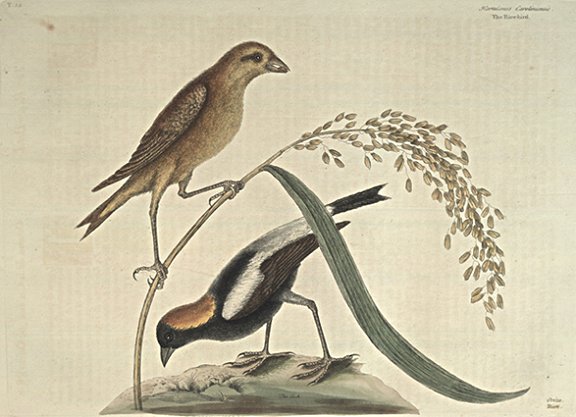Plate Number: I 14Hortulanus Caroliniensis: The Rice-Bird In the beginning of September, while the Grain of Rice is yet soft and milky, innumerable Flights of these Birds arrive from some remote Parts, to the great detriment of the inhabitants. Anno 1724, an Inhabitant near Ashley river had forty acres of Rice devoured by them, that he was in doubt, whether what they had left, was worth the expence of gathering in. They are esteemed in Carolina the greatest delicacy of all other Birds. When they first arrive, they are lean, but in few days become so excessive fat, that they fly sluggishly and with difficulty; and when shot, frequently break with the fall. They continue about three weeks, and retire by that time Rice begins to harden. There is somewhat so singular and extraordinary in this Bird, that I cannot pass it over without notice. In September, when they arrive in infinite swarms, to devour the Rice, they are all Hens, not being accompanied with any Cock. Observing them to be all feather'd alike, I imagin'd they were young of both sexes, not perfected in their colours; but by opening some scores prepared for the spit, I found them to be all Females; and that I might leave no room for doubt, repeated the search often on many of them, but could never find a Cock at that time of the year. Early in the Spring, both Cocks and Hens make a transient visit together, at which time I made the like search as before, and both sexes were plainly distinguishable. The Hen, which is properly the Rice-Bird, is about the bigness of a Lark, and colour'd not unlike it on the Back; the Breast and Belly pale-yellow, the Bill, strong sharp-pointed, and shap'd like most others of the graniverous kind. This seems to be the Bird describ'd by the name of MAJA, Will. App. p.386. In September 1725. lying upon the deck of a Sloop in a Bay at Andros Island, I and the Company with me heard, three nights succesively, Flights of these Birds (their Note being plainly distinguishable from others) passing over our heads northerly, which is their direct way from Cuba to Carolina; from which I conceive, after partaking of the earlier crop of Rice at Cuba, they travel over sea to Carolina, for the same intent, the Rice there being, at that time fit for them. The Cock's Bill is lead-colour, the forepart of the Head black, the hind-part and the Neck of a reddish yellow, the upper-part of the Wing white, the Back next the Head black, lower down grey, the Rump white, the greatest part of the Wing, and whole Tail, black, the Legs and Feet brown in both sexes. |